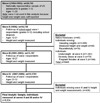Association of adolescent obesity with risk of severe obesity in adulthood
- PMID: 21063014
- PMCID: PMC3076068
- DOI: 10.1001/jama.2010.1635
Association of adolescent obesity with risk of severe obesity in adulthood
Abstract
Context: Although the prevalence of obesity has increased in recent years, individuals who are obese early in life have not been studied over time to determine whether they develop severe obesity in adulthood, thus limiting effective interventions to reduce severe obesity incidence and its potentially life-threatening associated conditions.
Objective: To determine incidence and risk of severe obesity in adulthood by adolescent weight status.
Design, setting, and participants: A cohort of 8834 individuals aged 12 to 21 years enrolled in 1996 in wave II of the US National Longitudinal Study of Adolescent Health, followed up into adulthood (ages 18-27 years during wave III [2001-2002] and ages 24-33 years during wave IV [2007-2009]). Height and weight were obtained via anthropometry and surveys administered in study participants' homes using standardized procedures.
Main outcome measures: New cases of adult-onset severe obesity were calculated by sex, race/ethnicity, and adolescent weight status. Sex-stratified, discrete time hazard models estimated the net effect of adolescent obesity (aged <20 years; body mass index [BMI] ≥95th percentile of the sex-specific BMI-for-age growth chart or BMI ≥30.0) on risk of severe obesity incidence in adulthood (aged ≥20 years; BMI ≥40.0), adjusting for race/ethnicity and age and weighted for national representation.
Results: In 1996, 79 (1.0%; 95% confidence interval [CI], 0.7%-1.4%) adolescents were severely obese; 60 (70.5%; 95% CI, 57.2%-83.9%) remained severely obese in adulthood. By 2009, 703 (7.9%; 95% CI, 7.4%-8.5%) non-severely obese adolescents had become severely obese in adulthood, with the highest rates for non-Hispanic black women. Obese adolescents were significantly more likely to develop severe obesity in young adulthood than normal-weight or overweight adolescents (hazard ratio, 16.0; 95% CI, 12.4-20.5).
Conclusion: In this cohort, obesity in adolescence was significantly associated with increased risk of incident severe obesity in adulthood, with variations by sex and race/ethnicity.
Figures
Comment in
-
Obesity in adolescence is associated with severe obesity in adulthood and worsening health problems.J Midwifery Womens Health. 2011 Mar-Apr;56(2):180-1. doi: 10.1111/j.1542-2011.2010.00054_3.x. J Midwifery Womens Health. 2011. PMID: 21429087 No abstract available.
References
-
- Mokdad AH, Ford ES, Bowman BA, et al. Prevalence of obesity, diabetes, and obesity-related health risk factors, 2001. JAMA. 2003 Jan 1;289(1):76–79. - PubMed
-
- Fontaine KR, Redden DT, Wang C, Westfall AO, Allison DB. Years of life lost due to obesity. JAMA. 2003 Jan 8;289(2):187–193. - PubMed
-
- Freedman DS, Khan LK, Serdula MK, Galuska DA, Dietz WH. Trends and correlates of class 3 obesity in the United States from 1990 through 2000. JAMA. 2002 Oct 9;288(14):1758–1761. - PubMed
-
- Sturm R. Increases in clinically severe obesity in the United States, 1986–2000. Arch Intern Med. 2003 Oct 13;163(18):2146–2148. - PubMed


